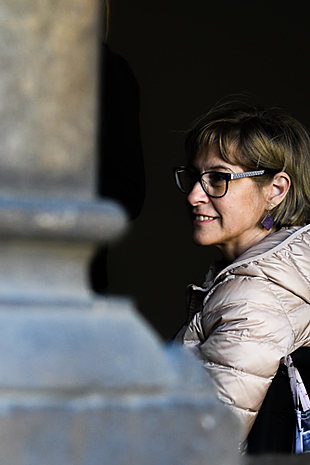Different Worlds. Musical Seas.
Different Worlds. Musical Seas.

To imagine is to take flight
To cross the emotional limitations
and break those of the body
To imagine is music for the soul
We are aware that music opens up imaginary worlds, it helps us to be more positive, creative, communicative … But can music heal? I don’t know the answer, but I can assure is that music is the bridge that connects people.
With this article, I do not intend to write an essay on the effect music has on people with some kind of ailment, because among other things, I am neither a psychologist nor a musician. But as a “storyteller”, I feel the need to explain a fabulous experience in which music is the vehicle of communication.
What the voice can’t say
A few months ago, I was fortunate to attend a music therapy session, as a guest, given by a psychologist for a group of physically and mentally disabled children. The words of these boys are formed by guttural noises and these, in turn, transformed into melody.
Once a week, I tiptoed in the music therapy session where I was in front of a group of four people with severe cerebral palsy and autism. Each one navigates in their individual worlds and they practically do not interact with each other, but the psychologist, a little man with a guitar that distills roses and wisdom, has the magic and experience of diving into those seas to fill them with musical notes and gradually bring them closer to reality
It is curious, because at the beginning I explained that music opens imaginary worlds for us, but with this I did not want to contradict myself with my last reflection; I firmly believe that music balances, elevates you to heaven and helps you to step firmly on the ground, as the case may be.
I will recount some of my experiences in the sessions of this unique therapy, but first I warn you, that for reasons of privacy, the names of these people have been changed. The purpose of this text is purely altruistic and with it I do not intend to hurt any person; on the contrary, they are anonymous heroes who have taught me that small achievements are always great victories.
The people in the group are Richard Wagner, Amadeus Mozart, María Callas, Robert Schumann, and their inseparable master of ceremonies. They do the music therapy session in a dark room, but with colored lights that cross the ceiling like nervous little fish in a pond. It is a group of porridge heads (who are sitting in a circle, some in wheelchairs) not because they refuse to follow the natural course of life, but because of an absurd caprice of destiny that the rest of mortals do not quite understand.
The music therapist, the little man and his inseparable guitar, enters the room and with a laughing voice greets the group of geniuses. No one answers, except Mozart’s laughter that is full of gratitude that bounces playfully on the walls. Amadeus Mozart is a boy who cannot speak, but his look that contains a million suns and his contagious laugh are his best language. The little man begins to caress the strings of the guitar and his voice is intermingled with the colored lights. Wagner joins in with a somewhat lost look, clapping happily and trying to keep the rhythm of the melody. The music therapist begins the session by greeting each kid with a personalized melody and song.
Richard Wagner, the euphoria of hands:
For this one music is a means of communication, since the compass that guides his hands and the movement of his head seem to carry the same rhythm. The world for Richard Wagner is a great symphony and people are instruments that are divided into three large groups: strings, winds, and percussion. He is always the conductor. Because beyond music, in the real world, there is very little to enjoy. Richard at his thoughts … applause and more applause, while vigorously affirming with his head.
When Richard realizes that the music therapist is in front of him, his hands are lit in euphoria. This brave musician is a string being, thinks Richard Wagner, because he always travels with an instrument drawer and his guitar hanging on his shoulder … That string man likes it, because he also lives in the same world and they both use the same language: music. The musician offers you a percussion instrument. Yes, I am percussion! Richard meditates while giving a great earthly smile.
The string being dedicates a voice so precious that Richard Wagner forgets that he is the conductor, therefore he is carried away by the melody created by the two of them. Applause and more applause.
The music of the hands has the most beautiful rhythm arising from the beating of the heart.
The lives of Robert Schumann:
Robert is a boy of robust build and frank smile; his walks are clumsy and heavy, the important thing is that he always arrives at the same places as the others. Robert’s ambiguity has no parameters, he lives between two waters; he rocks between the real world and his world, he is curious and distracted, he is bold and shy in equal parts. Robert is the closest thing to a melody that starts smoothly, but ends with a big surprise.
One of Robert Schumann’s most entertaining hobbies is to complicate the work of the poor music therapist who travels with his eternal aura of modern bohemian, surrounded by music. What is music? It is something that is not even seen. Jopetus! Of course it is to live between two lives, Robert thinks, meanwhile the guitar player tries to get his attention. The instrument begins to sing, but after a few minutes it fades away from sadness and it is when Robert grips the chopsticks smiling, starting to hit the small drum in front of him. Play without passion, without rhythm, but play. Robert is not entirely aware of playing music, because this music comes from the real world. And so, note by note, the music therapist walks away with a sparkle that shines in his eyes. Robert doesn’t know that this time they won it.
The important thing is not to know what life music comes from, but that music exists in every life.
Amadeus Mozart, a laughter called music:
The best melody I have ever known is the exotic mixture of laughter and the jingle of bells. His laugh is full of life, his optimism that arises from his gaze and his bells, which live in his left hand by way of communication. That is Amadeus Mozart and his best way of introduction. Only his head and his left hand have movement, so Amadeus, a boy with a thin body and pianist fingers, lives with his inseparable wheelchair, which has the same character as him. They both share joy wherever they are, while the bells translate their words and feelings.
For Amadeus, music is religion. Breathe music, feed on music and make your laughter a beautiful song. For Amadeus, the music therapist is a God descended from the Olympus of the staves, and that guitar has the hypnotic power of transforming his eyes into two large planets with a bass clef drawn on his lips. It is difficult to describe what Amadeus feels when his God begins to caress the strings of the guitar, the rattle sounds so much that the souls of his gaze envelop the music therapist with fascination, so it is confusing who gives therapy to whom.
The bells sometimes vibrate jubilantly and sometimes agonized with joy. The laughter and the melancholic sounds that interspersed Amadeus’ throat mix with the song of his God. At that time, therapy does not matter; There is only Amadeus, the music therapist and a guitar that dies of beauty.
The most divine music is the one that is born and blooms with laughter.
The skin of María Callas:
María is an enigmatic girl since her disability makes her live within a painting whose colors are very diffuse and difficult to understand. It’s always floating above our heads like a lake-eyed nymph. And when it finally touches the ground, it’s because the guitar notes welcome it; then descend gently to the earth.
The music therapist sings a song in which she, and only she, is the protagonist. The girl raises her face descending to the outside world; she observes the man who has been singing for years, but does not know his name. she speaks with her gaze; she also maintains this silent dialogue that mixes with his guitar notes. Maria’s little hands navigate through the air until she finds the instrument’s wood, very close to the vibration of the strings. Her little hands rest there, while the music penetrates tenderly through them and vibrates through her entire body. On her lips a crescent appears as a gift for that little bit in reality. The whisper of a guitar has been recorded on her body.
Ears aren’t always the best option; when music is heard on the skin is when you become a musical instrument.
The parachute and the union of geniuses
In the sessions, the music therapist does much more than I have narrated here, but I’m not going to explain everything because this text would get too long. But I will tell you about the dynamics of the parachute.
The parachute is a large brightly colored fabric that has the shape of a parachute, in its multiple edges they have handles to make its handling easier. The objective of this exercise is simple and difficult at the same time, creating a group unity.
Robert Schumann, Richard Wagner, Amadeus Mozart, María Callas, the master of ceremonies, and the music therapist grab the parachute by one end. At the rhythm of “Va Pensiero” they move the cloth up and down. Colors that dance, float and penetrate the hearts of those who are there. Among the waves of clothes, the little ones look amazed. They are not alone! They are a unit, a unit of musical seas. They are not alone! While the music lasts there will be reality.
Dedicated to Egoitz Urberuaga, creator of realities and musical seas.
Pili Egea







